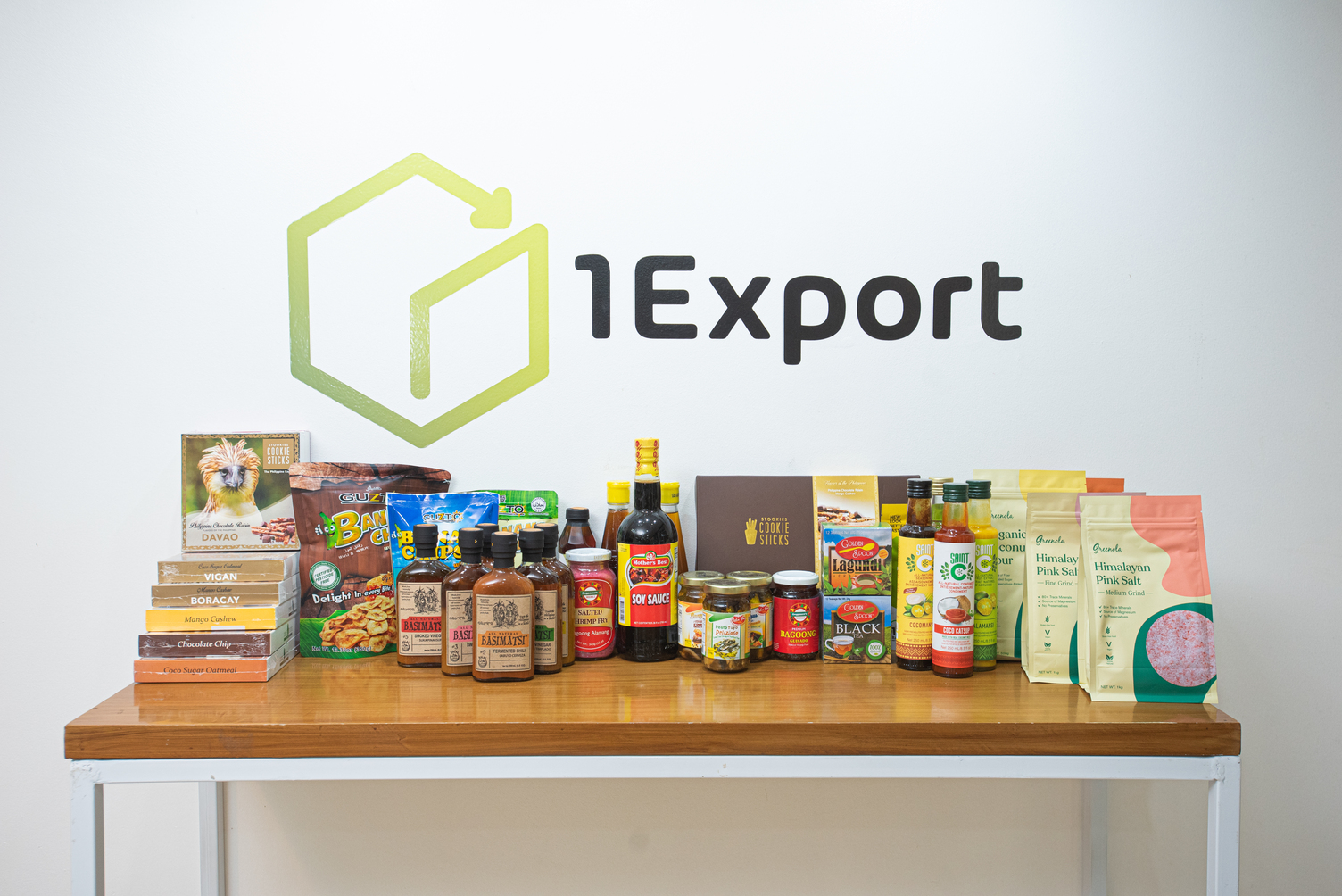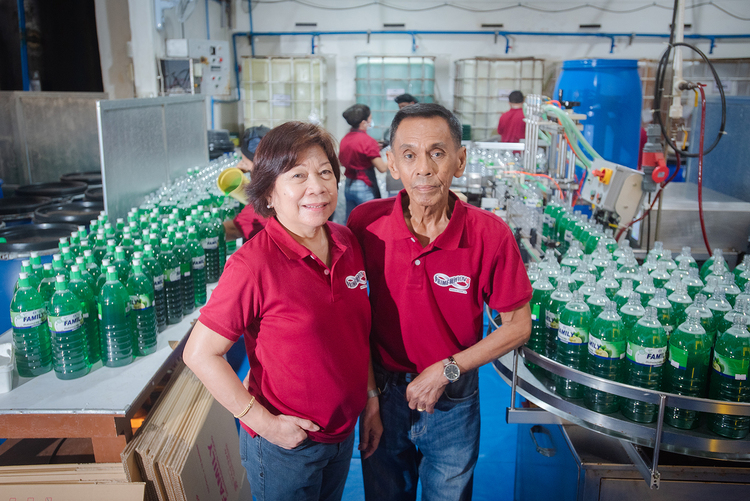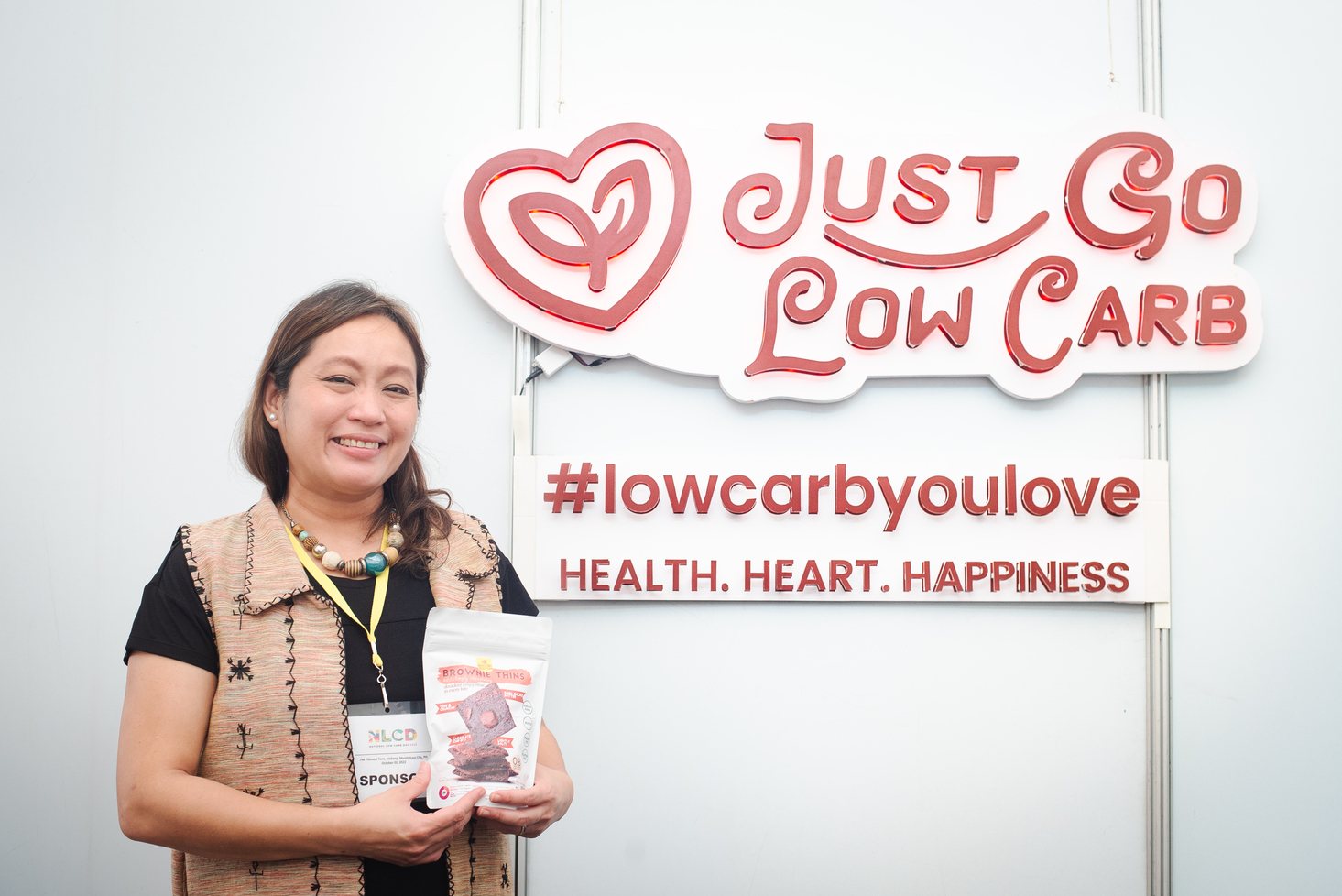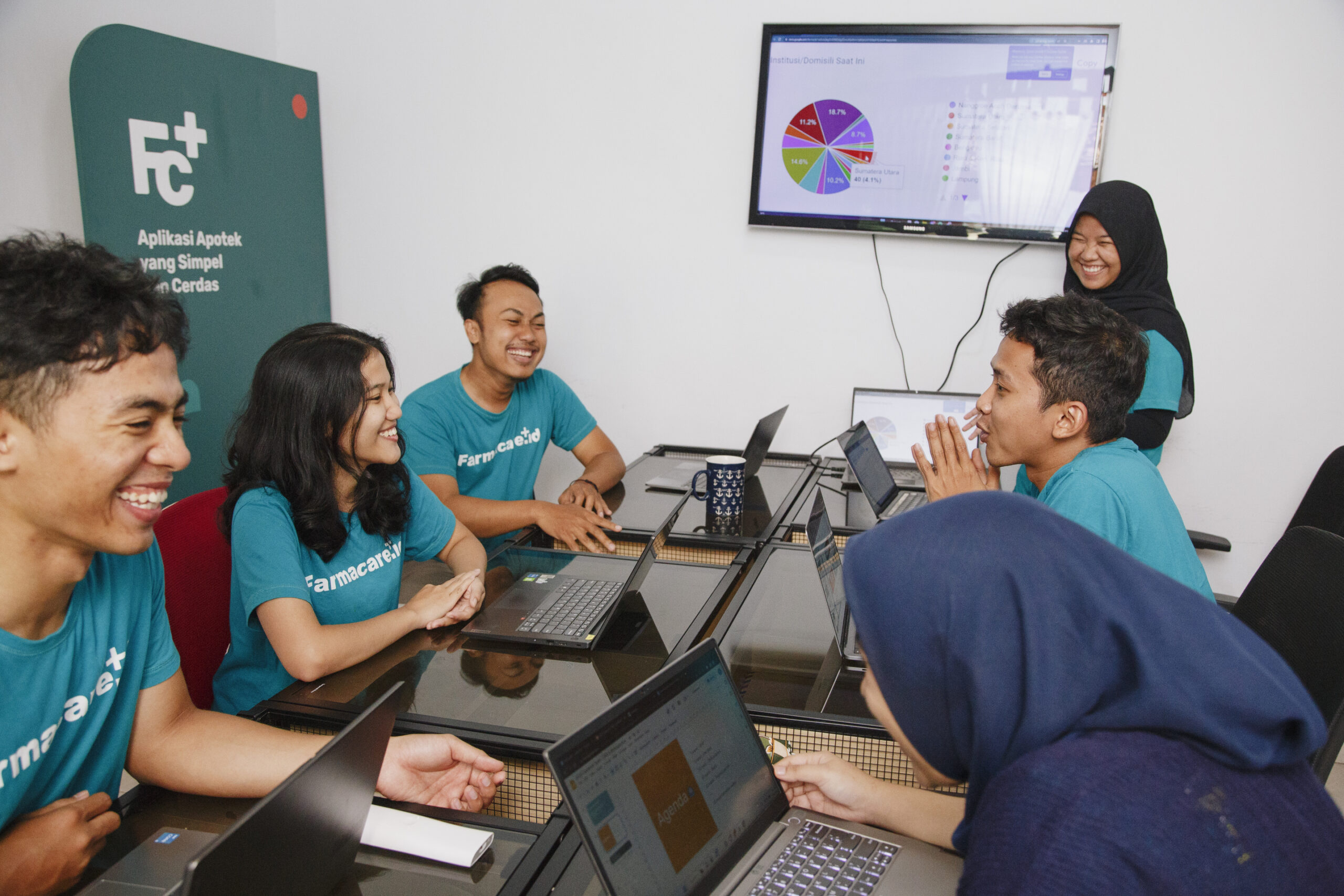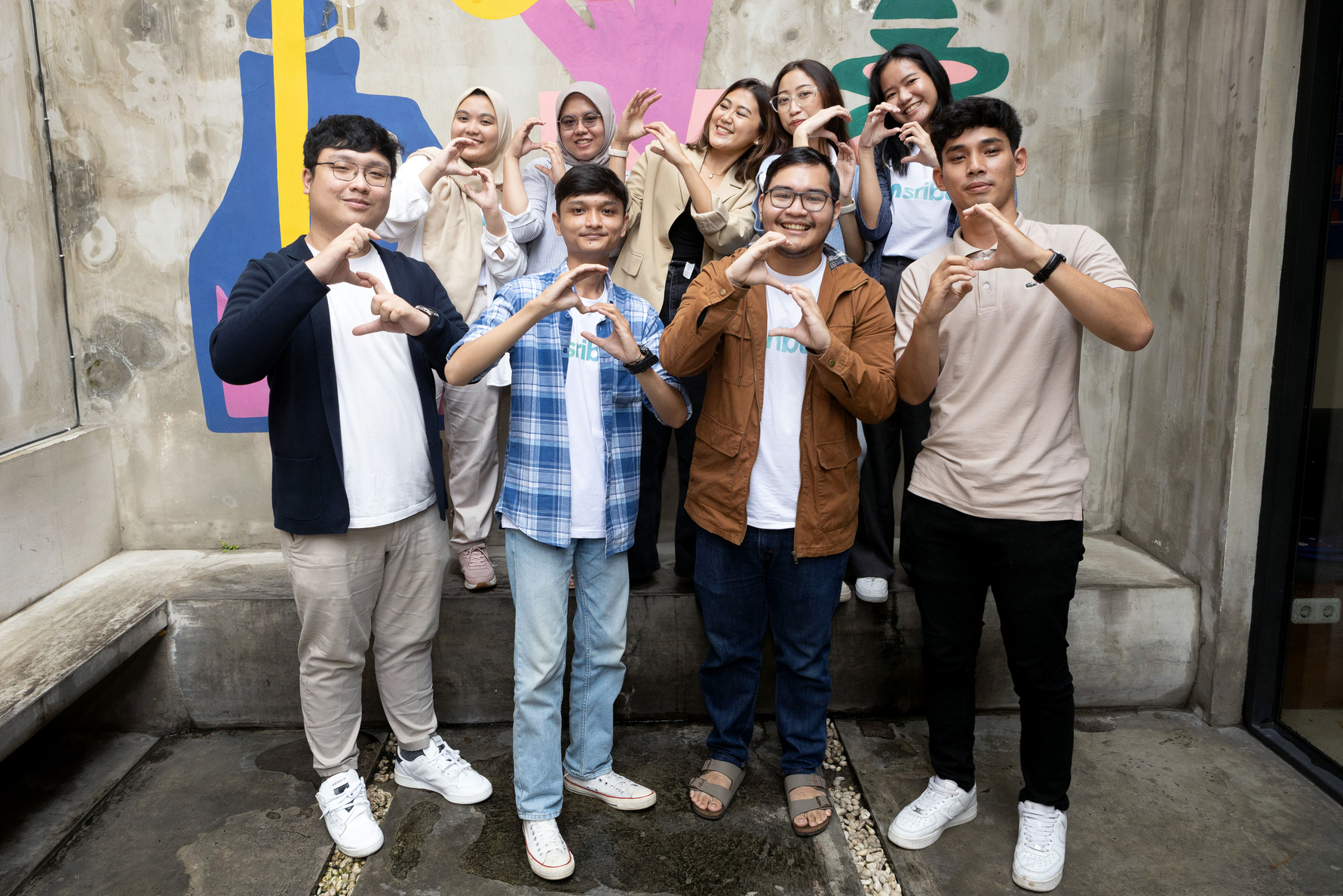IW Women’s SMEs – Livegreen International
IW Women’s SMEs – Livegreen International

In this photo: Registered nurse turned vegetable dealer, Rachelle Patot, overlooking her ‘sayote mountain’. Hidden behind the mountains of Tublay, Benguet, Philippines is a gem of vegetable pear (or ‘sayote’ in Filipino) farm owned by Rachelle Patot. Rachelle runs Wirawel Vegetable Trading (WVT), which supplies a range of produce to major vegetable retailers in Manila and Batangas—including Livegreen, an inBest Ventures investee company.
© 2024 by Investing in Women licensed under CC BY-NC-ND 4.0

In this photo: The leaves and vines vastly cover the steep slopes of this mountain in Benguet, a habitat where the 'sayote' plant thrives the most, giving Rachelle weekly harvest. According to her, 'sayote' farms can get very busy due to its weekly harvest. Growing 'sayote' is easy once you have installed the roof trellis for the vines to crawl. It will thrive in slopes of the mountain, and can give a farmer weekly harvest of healthy and clean vegetables, that is free from pesticides and chemical fertilizers.
© 2024 by Investing in Women licensed under CC BY-NC-ND 4.0

In this photo: A farmer harvests 'sayote' or vegetable pears that are ready for distribution. Vegetable pear vines crawl to the wire trellis, and can grow bushy as one walks further down the slope under the trellis to harvest crops. The 'sayote' plant can be quite challenging to harvest because of the mountain's very steep slope, but once one gets used to the gravity, it is easy to pick the vegetables by an arms’ length.
© 2024 by Investing in Women licensed under CC BY-NC-ND 4.0

In this photo: A close up of the 'sayote' or vegetable pear, freshly plucked from its vines. This vegetable is considered one of the safest and healthiest to eat because it does not need pesticides and chemical fertilizers to grow.
© 2024 by Investing in Women licensed under CC BY-NC-ND 4.0

In this photo: Pulleys made of thick ropes and a hanging shelf made of steel are used to help the harvest of vegetable pears less challenging for farmers. Since harvesting 'sayote' can be very arduous due to their weight and the distance needed to be covered to transport them, farmers have invented a mechanism to easily transport them from the sloped harvest site to plain ground. By using pulleys made of thick ropes and hanging shelf made of steel, farmers can easily secure the harvested crops on the shelf and simply pull it back to get the harvest.
© 2024 by Investing in Women licensed under CC BY-NC-ND 4.0

In this photo: Rachelle Patot in the middle of her farm with a sack of freshly harvested green beans. Surrounding her are wall trellises needed for green beans; the bamboo sticks are tethered to form diamond shaped walls.
© 2024 by Investing in Women licensed under CC BY-NC-ND 4.0

In this photo: Rachelle harvesting green beans. In her farm, Rachelle also grows zucchini and green beans (locally termed as 'Baguio beans'), which are her main products. Locally called as 'Baguio beans', these green beans only take 1.5 months to mature.
© 2024 by Investing in Women licensed under CC BY-NC-ND 4.0

In this photo: Land preparation at Rachelle’s farm in Tublay, Benguet. This lot has already been plowed and row-spacing for flat soil beds is now being prepared. To do this, a farmer measures the distance between the beds by using the marker at the middle of the stick. He will then dig into the soil to create his marker for spacing. This process is repeated at the other end before digging the rows to establish the bed spacing.
© 2024 by Investing in Women licensed under CC BY-NC-ND 4.0

In this photo: A close up of a farmer planting green bean seeds. After installing the walled trellis for the green beans, the farmer can start planting the beans.
© 2024 by Investing in Women licensed under CC BY-NC-ND 4.0
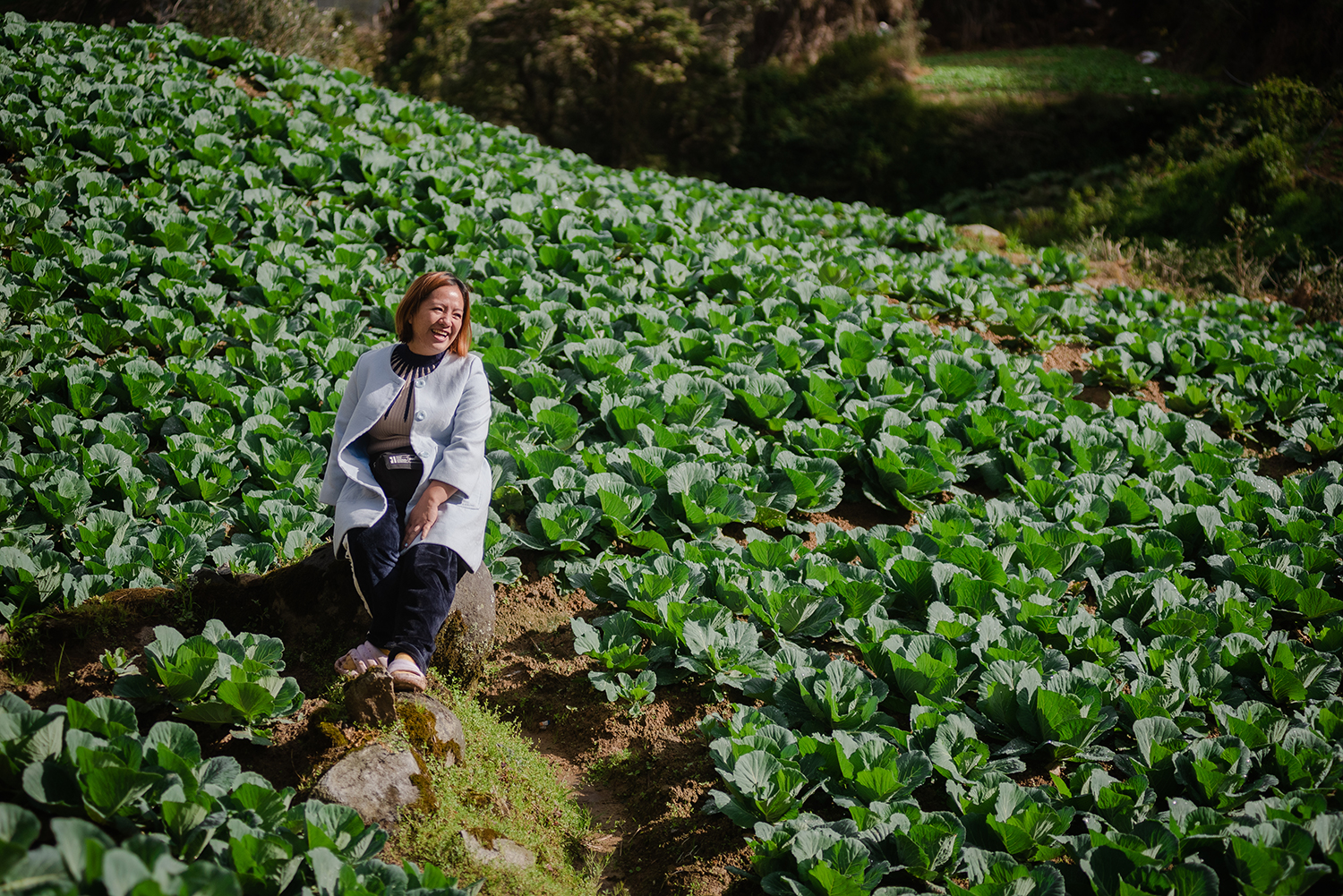
In this photo: Sarah Atting, owner of Kaze Organic Farm (KOF), at her cabbage farm in Natubleng, Buguias, Benguet. KOF is a Livegreen-supported enterprise that consolidates vegetable products from small farmers in Benguet, Philippines. Their main produce is cabbage, with several other beds for crops like potatoes and carrots.
© 2024 by Investing in Women licensed under CC BY-NC-ND 4.0

In this photo: The beautiful cabbage farm of Sarah Atting in Natubleng, Buguias, Benguet. Showing off its outer leaves, these cabbages will then grow into a globe of layers of compacted leaves, ready for harvest in approximately a month. Cabbages take 2-3 months to mature. The pond at the middle of the field is a part of the irrigation system of the farm.
© 2024 by Investing in Women licensed under CC BY-NC-ND 4.0

In this photo: Sarah walking along her potato patch; seen on the background is her multi-layered cabbage beds. Sarah started farming way back in 2009 and now owns three farms in the highlands of Natubleng, Buguias, Benguet, growing various crops such as carrots, marble potatoes, cabbage, wombok, broccoli, and green ice.
© 2024 by Investing in Women licensed under CC BY-NC-ND 4.0

In this photo: Sarah walking at the middle of her carrot farm. Sarah's main produce is cabbage, with several other beds for crops like potatoes and carrots, as well as leafy vegetables, like wombok and green ice, to balance the market demand and off-peak seasons. Sarah loads approximately 3-4 tons of produce per truck, filling 5-6 trucks per month during peak seasons.
© 2024 by Investing in Women licensed under CC BY-NC-ND 4.0

In this photo: Sarah happily holding carrots she just harvested from her farm in Natubleng, Bugias, Benguet. This farm, situated at the highlands of the town, is 6,000 sqm. and boasts in healthy carrot crops with several other beds for broccoli to balance the market demand and off-peak seasons.
© 2024 by Investing in Women licensed under CC BY-NC-ND 4.0

In this photo: Sarah explains that “no land is wasted” in her cabbage farm. Behind her are multi-layered beds of cabbage successfully growing even in corners and strips of the mountain. By maximising the land, Sarah can produce a combined harvest of 15-20 tons of crops and leafy vegetables in a month from her three farms during peak seasons.
© 2024 by Investing in Women licensed under CC BY-NC-ND 4.0

In this photo: Sarah showing how to harvest potatoes at her farm; one has to dig deeper to get all the potatoes out. Potatoes reach maturity 2-3 months after planting.
© 2024 by Investing in Women licensed under CC BY-NC-ND 4.0
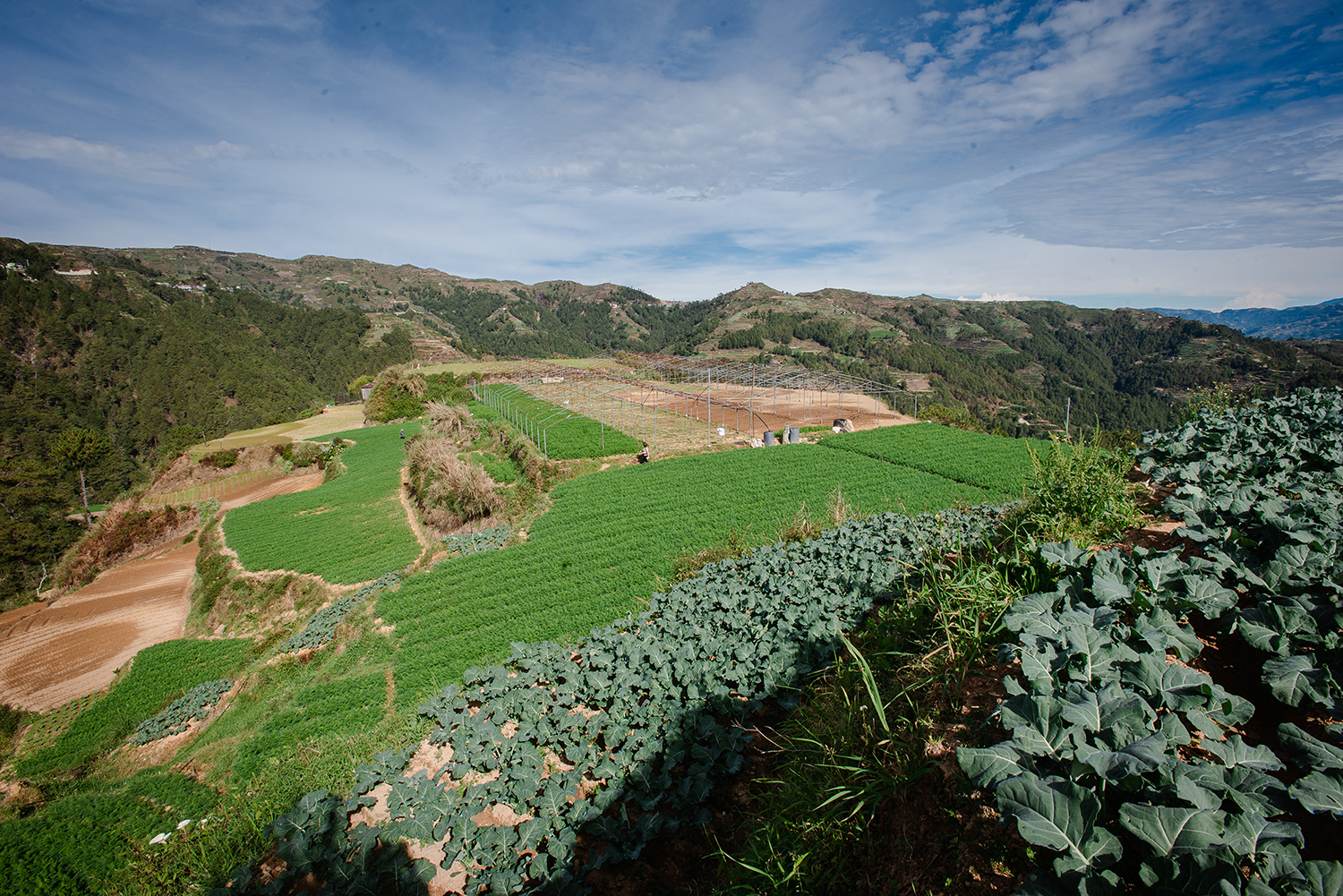
In this photo: A sunny day at Sarah Atting’s carrot and broccoli farm, in Natubleng, Buguias, Benguet. On the upper part of the mountain on the lower right of the frame are broccoli leaves that have been transplanted. Farther down with the lighter green leaves are the carrots. Land that have just been prepared for planting can also be seen on both sides of the mountain. This farm on the highlands of Natubleng is about 6,000 sqm.
© 2024 by Investing in Women licensed under CC BY-NC-ND 4.0

In this photo: Sarah Atting harvesting carrot crops. From planting to thinning and growing, carrots mature faster, taking it only two to almost three months to be ready for harvest.
© 2024 by Investing in Women licensed under CC BY-NC-ND 4.0

In this photo: A farmer holds the carrots which Sarah has pulled out. A pertinent activity in carrot farming is called thinning, wherein after a month from planting, the farmer pulls out baby carrots from the row to free up more space for others to grow to full size.
© 2024 by Investing in Women licensed under CC BY-NC-ND 4.0

In this photo: Sarah thinning the carrots that have been newly planted at her farm. Thinning is done by carefully pulling out some of the carrots—a crucial activity in carrot farming as it gives more space for the rest of the carrots in the row to fully mature.
© 2024 by Investing in Women licensed under CC BY-NC-ND 4.0

In this photo: A farmer spraying fumicide onto growing crops. Another farm activity is spraying. Using a fumicide with natural contents, it is sprayed to aid in the healthy growth of the crops.
© 2024 by Investing in Women licensed under CC BY-NC-ND 4.0

In this photo: A farmer cleaning the remains from the recent harvest and manually plows the soil to loosen up the particles. Work never stops at the farm. After harvest, land preparation is done for another batch of carrot planting. A tractor for plowing (not in photo) is also used in Sarah Atting’s carrot farm.
© 2024 by Investing in Women licensed under CC BY-NC-ND 4.0

In this photo: Sarah Atting’s newly operational tomato farm is a downhill walk from the main road in Wangal, and is hidden amongst the forest of La Trinidad, Benguet. The tomato farm is 7,000 sqm.
© 2024 by Investing in Women licensed under CC BY-NC-ND 4.0

In this photo: Beth Sagamla, a farmer who has been working with Sarah for over eight years, searches for tomatoes that can be harvested from Sarah's farm in Wangal, La Trinidad Benguet. A good tomato that is ready for harvest is one with a slight yellow or orange color on its skin. At the time when the photo was taken, it, it was the farm’s first cropping since it has operated.
© 2024 by Investing in Women licensed under CC BY-NC-ND 4.0

In this photo: A close up of a tomato with tints of orange colour, about to be plucked by Beth. A tomato that is good for harvesting has a tint of yellow or orange on its skin. At the time when the photo was taken, it was the farm’s first cropping since it newly operated.
© 2024 by Investing in Women licensed under CC BY-NC-ND 4.0

In this photo: Norma Saltico harvesting her weekly produce of spinach. Norma is the owner of Normalou Farms, which grows spinach and consolidates vegetable produce for Livegreen Inc., and other markets.
© 2024 by Investing in Women licensed under CC BY-NC-ND 4.0

In this photo: Norma harvests 80-100 kilos per day, which sums to about 500 kilos per week. Norma started spinach farming in 2008, with just P2,000 pesos seed money, producing only 2 cartons per harvest. Today, her 2,000 sqm. farm has two separate greenhouses, protecting the spinach from heavy rains.
© 2024 by Investing in Women licensed under CC BY-NC-ND 4.0

In this photo: Healthy greens. A close up of Norma’s organically grown spinach. Norma prefers growing spinach because it is easy to grow and cook, and is very nutritious.
© 2024 by Investing in Women licensed under CC BY-NC-ND 4.0

In this photo: Another activity in Norma’s spinach farm is seedling growing. Norma inspects a bed of transplanted spinach seedlings for worms, which should be removed to avoid damage to the baby spinach.
© 2024 by Investing in Women licensed under CC BY-NC-ND 4.0

In this photo: A frequent activity in Norma’s farm is weeding. Once the transplanted seedlings start growing, removing the growing weeds as well amongst them is necessary so as not to crowd the spinach and share soil nutrients.
© 2024 by Investing in Women licensed under CC BY-NC-ND 4.0

In this photo: Norma’s spinach farm is situated between mountains in Tawang, La Trinidad, Benguet. From the main road, it’s about a minute walk down a steep hill before reaching the quaint, 2,000 sqm farm. Seen in the photo is newly planted spinach and two greenhouses on both sides.
© 2024 by Investing in Women licensed under CC BY-NC-ND 4.0

In this photo: The entrance of the Livegreen warehouse with workers doing simultaneous tasks of sorting and trimming. A variety of organic produce from the nine growers of Livegreen Inc. in Benguet are transported everyday to the warehouse in Betag, La Trinidad, Benguet.
© 2024 by Investing in Women licensed under CC BY-NC-ND 4.0

In this photo: Carrots and cucumbers have just arrived at the Livegreens warehouse in La Trinidad, Benguet. It will then be trimmed, dried, sorted and weighed for distribution to various mid-high end markets in Metro Manila.
© 2024 by Investing in Women licensed under CC BY-NC-ND 4.0

In this photo: A worker separates the small from the medium-sized tomatoes. The produce are prepared for distribution to various mid-high end markets in Metro Manila; trimming, sorting, drying, weighing are the everyday activities to assure adherence to Livegreens’ standards of quality.
© 2024 by Investing in Women licensed under CC BY-NC-ND 4.0

In this photo: A detailed view of sorting and trimming of varying crops and leafy vegetables. At a separate room in the middle of the warehouse, carrots and potato marbles (not seen in the photo) are dried using an industrial fan, since most of the crops brought here have been washed and are still wet.
© 2024 by Investing in Women licensed under CC BY-NC-ND 4.0

In this photo: Beetroots, tomatoes, and wombok that have just been brought here are trimmed and sorted simultaneously. To keep the standards of Livegreen, workers sort the crops and leafy vegetables according to size, color, weight and texture. Trimming of wombok by slicing the stalk and removing bad leaves.
© 2024 by Investing in Women licensed under CC BY-NC-ND 4.0
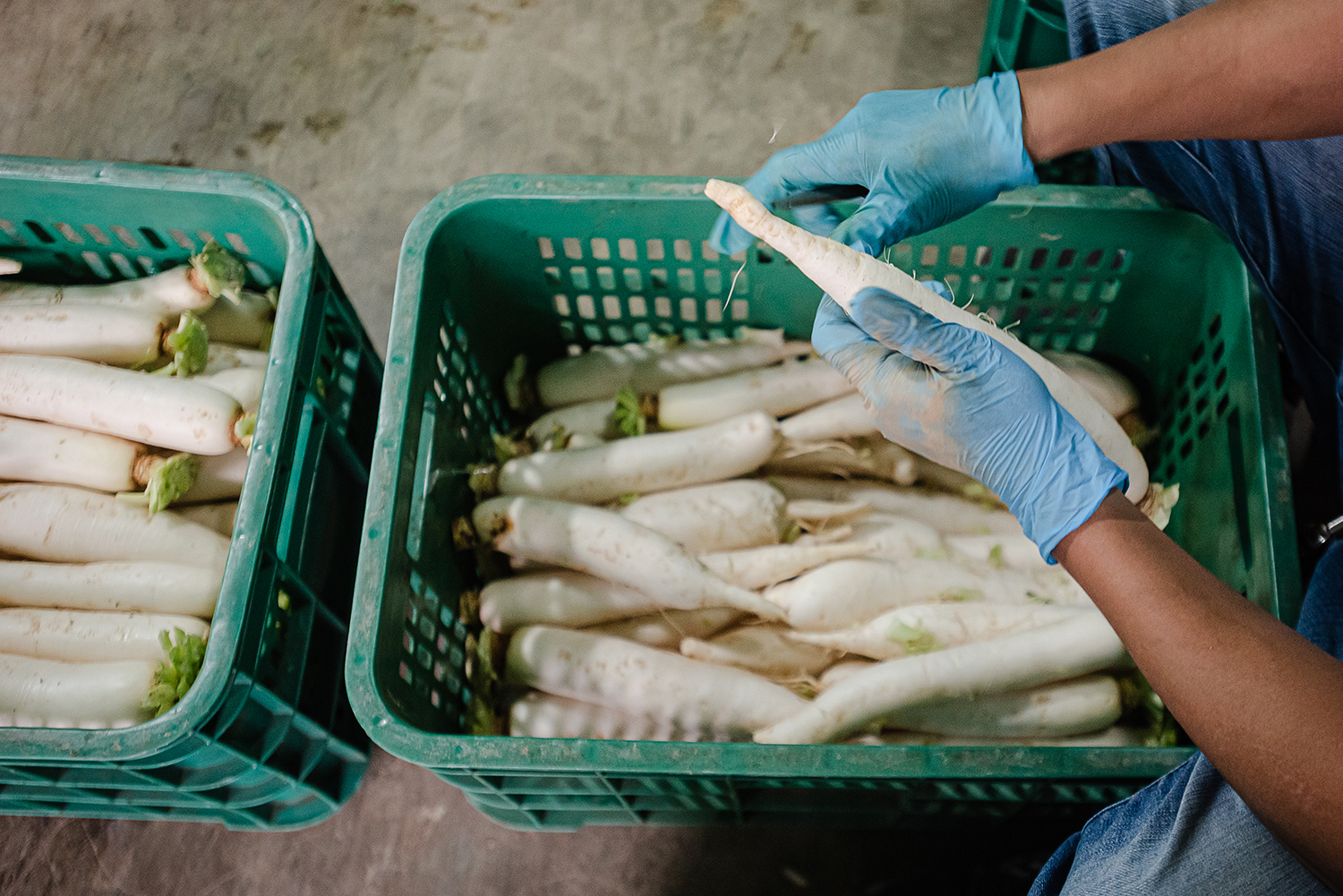
In this photo: Trimming of radish that have just arrived at the warehouse of Livegreen Inc. in La Trinidad, Benguet. Workers need to cut the stalks, remove or cut excess or bad leaves as well as the protruding roots of the crops.
© 2024 by Investing in Women licensed under CC BY-NC-ND 4.0

In this photo: A worker puts 'Class A' wombok on a crate to be readied for weighing and distribution. 'Class A' wombok weighs 300-900 grams, while 'Class B' weighs a kilo. Rejected wombok, which weighs either below 300 grams or above 1 kilo, is returned to the growers.
© 2024 by Investing in Women licensed under CC BY-NC-ND 4.0

In this photo: Two workers scoop the marble potatoes and pack them on plastic bags for distribution to various markets of Livegreen Inc. in Metro Manila. The potatoes and carrots shown in this photo have been fanned to dry, as they were brought at the warehouse washed and wet. Drying of crops that have arrived early in the afternoon, or when the weather is hotter, takes about an hour to an hour and a half to dry, while drying later in the day, or when the weather is cooler, takes about three hours to finish.
© 2024 by Investing in Women licensed under CC BY-NC-ND 4.0

In this photo: The crops after drying is then sorted and packed on plastic bags for distribution in various markets in Metro Manila. Crops such as potatoes and carrots shown in these photos have already been washed and cleaned before bringing it to the warehouse. As soon as it arrives, the carrots are trimmed and dried for an hour and a half, or up to three hours, if the weather is cooler.
© 2024 by Investing in Women licensed under CC BY-NC-ND 4.0

In this photo: Workers sort the carrots according to size and texture before distribution to various mid to high end markets in Metro Manila. They look for holes and sores on the crop’s skin, and separate the sizes. Specifically in carrots and potatoes, different markets have different size preferences (small, medium and large), which are therefore prepared according to orders. Rejected crops will be sent back to the farmers.
© 2024 by Investing in Women licensed under CC BY-NC-ND 4.0
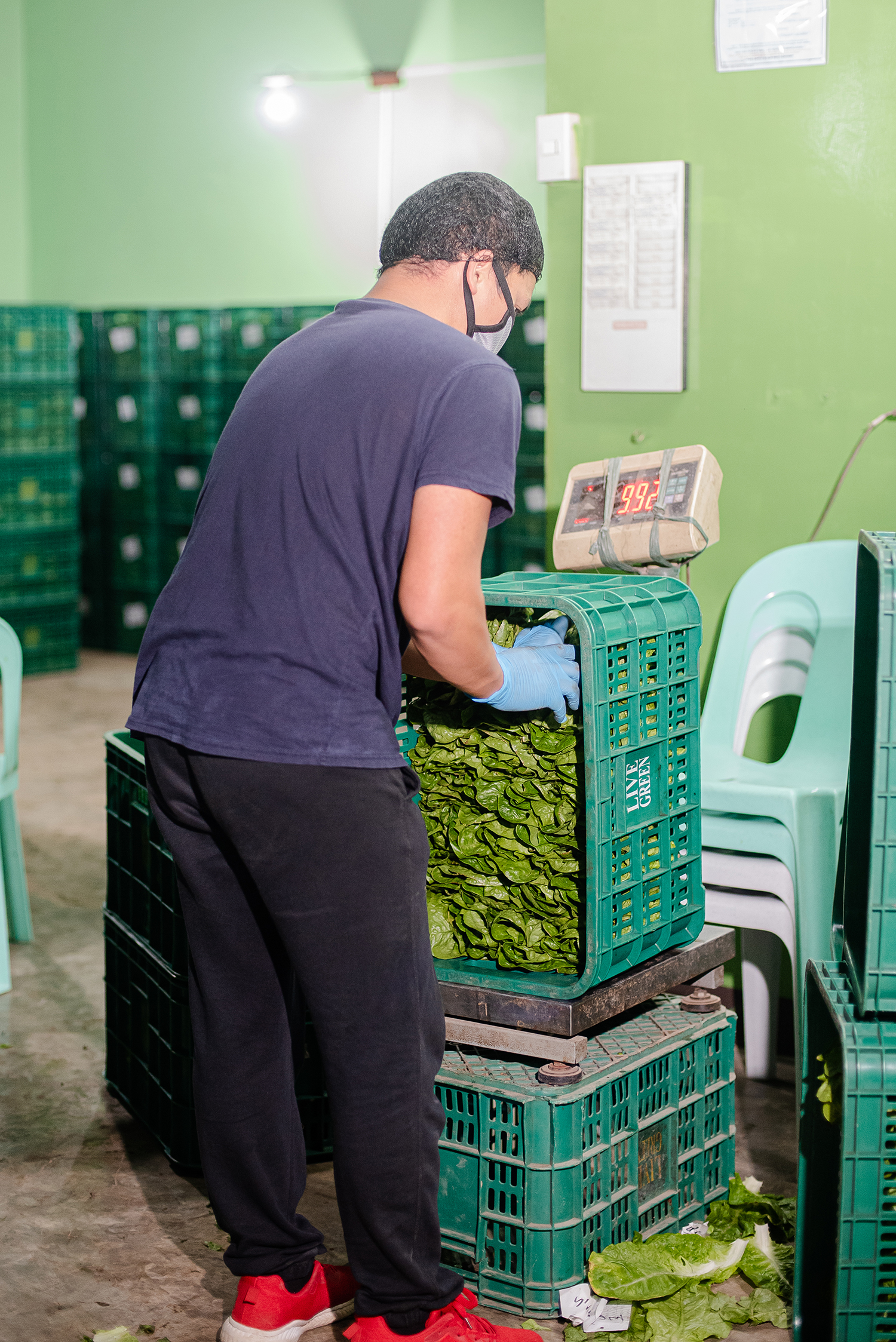
In this photo: A worker weighing a crate of Romaine lettuce. Another activity in the Livegreens warehouse in Betag, La Triniad, Benguet is weighing the produce according to the specific market’s order.
© 2024 by Investing in Women licensed under CC BY-NC-ND 4.0
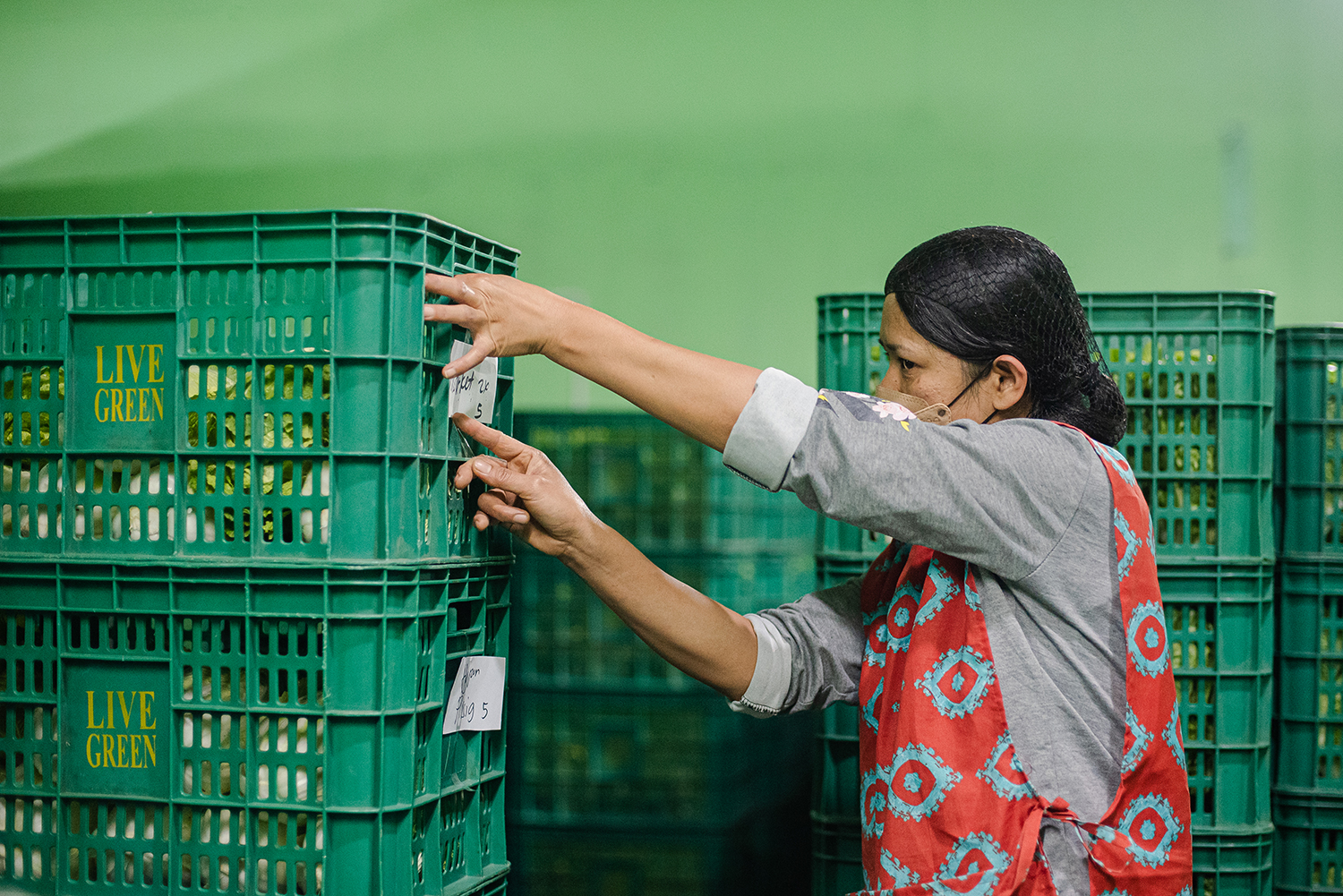
In this photo: After weighing, the crates are properly labelled according to the names of the supermarkets, malls or stores in Metro Manila where each order will be distributed. Mary Ann, the head of distribution of Livegreen Inc. warehouse in Betag, La Trinidad, Benguet, properly tapes the label on a piece of paper, and checks paper works to finalize orders and distribution.
© 2024 by Investing in Women licensed under CC BY-NC-ND 4.0
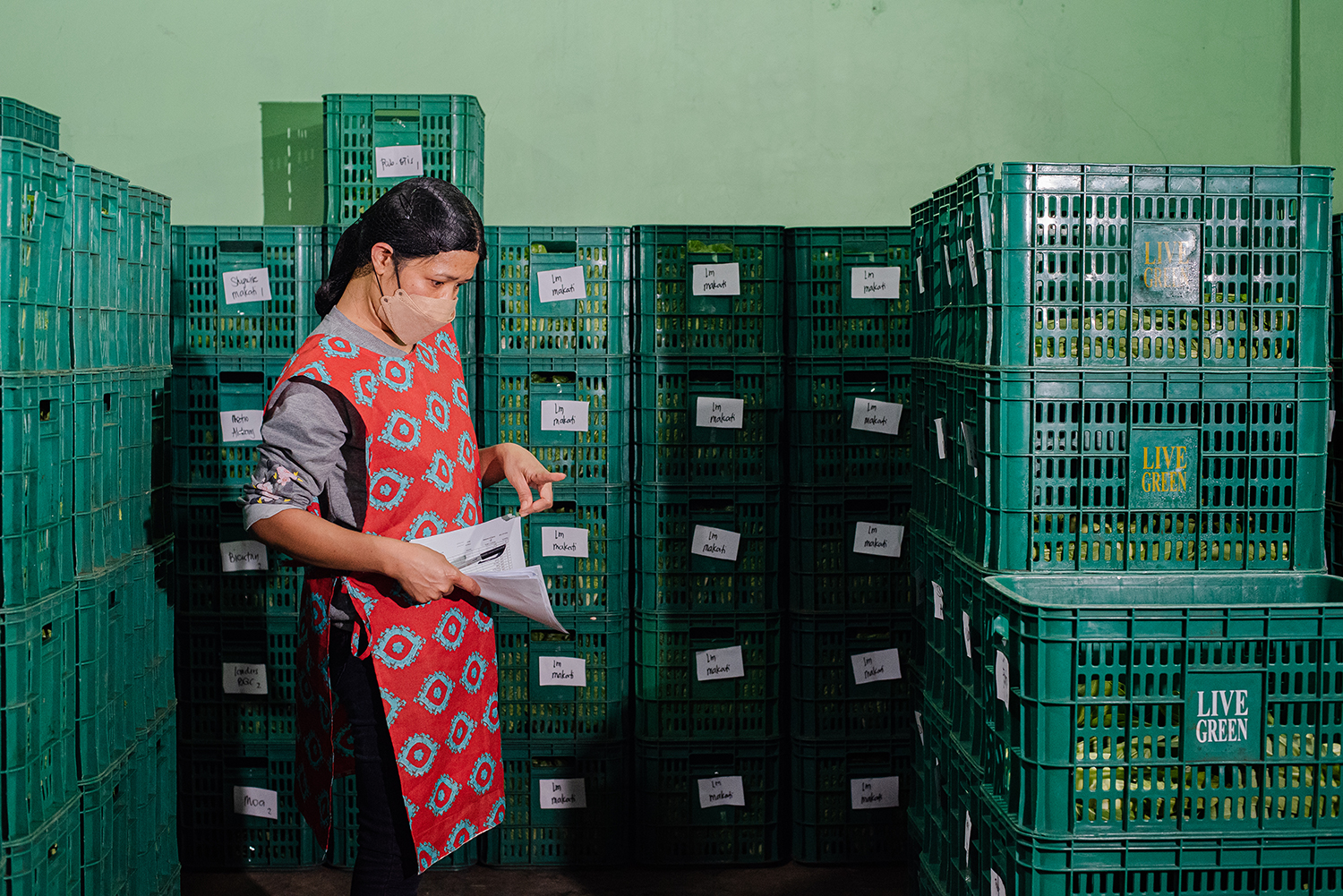
In this photo: The area where Mary Ann, the head of distribution of Livegreens warehouse in Betag, La Trinidad, Benguet, cross-checks the orders on the list with the stocks onsite. These crates will be delivered to major shopping malls in Metro Manila. According to Sarah Atting, Livegreen helps farmers by minimizing the risks associated to farming because with the sure market brought by Livegreen, they are able to calculate costing before planting starts.
© 2024 by Investing in Women licensed under CC BY-NC-ND 4.0

In this photo: Crates are filled up with wombok that have been separated according to size and weight. Class A wombok weighs 300-900 grams, while Class B weighs a kilo. Rejected Wombok, which weighs either below 300 grams or above 1 kilo, is returned to the growers. Livegreen aims to provide fresh, organic produce to mid and high end markets in Metro Manila, and help more growers to practice organic farming and widen their market.
© 2024 by Investing in Women licensed under CC BY-NC-ND 4.0
Terms of Use:
All materials presented on this Media Gallery is licensed under Creative Commons 4.0 International license.
The details of the relevant license conditions are available on the Creative Commons website (accessible using the links provided) as is the full legal code for the CC BY-NC-ND 4.0 license.
Content from this website should be attributed as Investing in Women, an initiative of the Australian Government – https://investinginwomen.asia.


